Mind Streaming
John Coxon's Online Journal|
Archive Search |
| Links |
|
and s-integrator |
Saturday, May 17, 2003
MIS-MARKETING WINES ?
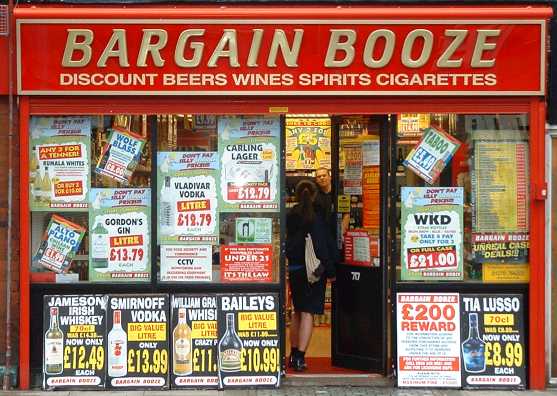
The consumption of alcohol at home in general here in the UK, has drastically increased quite recently, if the increasing amount of supermarket shelf-space devoted to beers, spirits and wines from all over the world is any indicator. We have also seen a growth in the number of off-licences and bargain booze shops on our high streets. (There is actually a retail high street franchise called BARGAIN BOOZE It seems that alcohol has become the number one form of self-treatment to counteract the increasing levels of everyday stress in living and working that many people feel.
The purchase for home use, of table wines used to be thought of as an essentially middle-class professional retail habit, but the volume of wine sales has really 'Blossom Hilled' and the competition within the market has led to falling prices, amongst modest wines at least, and thus the habit of wine drinking these days spans the complete social spectrum.
The competition and wider range of choice of wines inspired by this change in drinking habits has had consequences for some producers. The British traditional love affair with predominantly French wines has substantially waned through world wine experimental tasting and the French are losing out in the market to other nations (who all incidentally seem to opt, not for real corks but plastic ones. Thus not one bottle can be said to be corked or 'unfit to drink' as we call it). The French, it seems have lost that substantial share of the wine market perhaps through arrogance or complacency, and relatively cheap good wines from Australia, South Africa, and California are selling like hot cakes.
Supermarkets buyers are on the ball when it comes to selecting modestly priced wines that please and thus I can get a very acceptable bottle for around £4. There are varieties on offer for the more adventurous, at higher prices up to say £15 a bottle, but, when I have paid more, there seemed little to justify the extra payment in terms of my satisfaction.
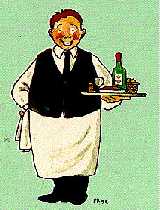
A French chevalier du vin ( who must remain anonymous lest he be struck off ),a member of one of those many mysterious French brotherhoods of wine connoisseurs, once told me the simple secret of how to select a reasonable bottle of wine. I am not sure if his rule of thumb applies world wide but, thus far it has always proved reliable to me. This is not about price, or the name or the label graphics. If the bottom of the bottle is completely flat, he said, don't buy. The quality of a wine is only as good as the amount of depth you can place your fattest digit into the dimple in the bottom of the bottle, the man told me. The logic is that, as a marketing ploy, volume producers of cheap wine prefer the bottle as the container of choice, but the wine has not developed in the bottle. The dimple suggests that the wine actually 'matured' in the bottle rather than having been spooned out of a vast wine lake and put in a non-descript bottle to make it more saleable.
Now then, to the subject in hand.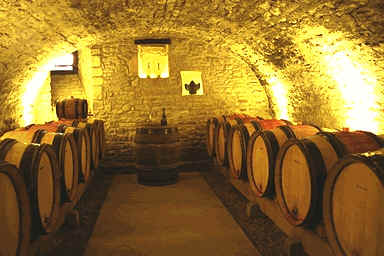
Throughout France there are long established 'Caves', ( sounds like calves and is French for cellars,) and châteaux who have often attractive labels bearing genuine images of, for example, chateau or some other motif related to its place of origin. 
Newcomers to the game will try to invent a coat of arms or chose a clip art, of say, a French stately home to suggest tradition and quality. England does not have the Californian, South African or Australian sun hours vines need, but non-the-less, there are a few great but small vineyards here that produce exquisite wines.
But, a nation, relatively new to the wine producing has a naming problem; the choice of 'appellation' can be extremely revealing. If the drink has a sort of 'pandering to British tradition and culture ' sort of name don't buy. If it simply gives a genuine, fairly un common place name, you may be safe. Take it from me , if, for example , the word 'Manor', or any other 'linked to UK culture' word appears on the label, it is probably a wise move not to buy or at least ask for references!
Now , as a reformed alcoholic, I was, rather fond of the wine box. Here, I could buy either three or five litres of quite reasonable stuff at a modest price. It was box-sealed in a foil bag and came with a handy plastic button tap and I could drink a lot without appearing to be excessive, whereas a standard see-through bottle just sort of declared my guilt. I have had some really great Sicillian and South African reds from wine boxes. But, earlier today, I had the wine-box-shock of my life with this little beauty of a deceiver.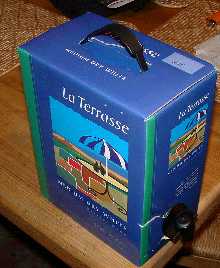
This is very probably, the very worst wine I have ever had the misfortune to let pass my not that discerning lips. Observe the box that deceived, and ,at my guess, was designed to do exactly that. Admittedly, we were in a big hurry; it wasn't expensiveat all and we just put it in the shopping cart without a second thought. At home I fiddled, as you have to do with boxed wines, and got the plastic tap in the right place and pressed the black tap button. My glass filled and I took a sip. It was probably the worst wine drinking experience of my entire life. In my haste I had been deceived by the packaging for the very first time and had failed to note the small print, adopting the generous 'Let's give this one a try' sort of cavalier attitude.
"La Terrase" , ah what visions that word conjures ; that place in the Mediterranean , outdoor-shaded part of the house, to enjoy that French afternoon sun where you can relax and enjoy your lovely chilled wine. Believe me , readers, here in this box, to my palette at least, is probably the drink that , in all my wine sipping days , has caused me more pain and disgust than any other. It was simply awful. Flat lemonade would be too flattering for it. Flat lemonade would have been nectar in comparison. If you have ever been to a party and sipped a glassful of diluted orange drink and it was one made by one of those mean people who just use enough cordial to turn the water orange, well that is the kind of dissatisfaction this wine evoked. Wine flavoured water is what this was.
How could I have been so deceived. Incredulous, I looked at the print on the box searching for a focus for my disbelief. ' Made in Britain' in feint font was a surprise but not necessarily a condemnation , and that adopted French name in Bold font along with that modern Mediterranean image had contrived to inspire a sort of confidence. Many good boxed wine tends to have such images but on reflection this one was part of a conspiracy. The box legally , but very quietly declared the alcohol content in feint font. Half of the norm, a mere 6as opposed to the standard 11 or 12And this company who lack the honesty to use a genuine English name and have the audacity to market this under the name 'wine' actually have a website. Most villains prefer not to leave an address but I hope sincerely that the rest of their offerings are considerably better than this aberration.
johncoxon 11:49 PM - [Link] - Comments ()
...
MY THOMAS THE TANK ENGINE
Friday, May 16, 2003

I had to smile when the BBC reported, March 11th 2003 that a British psychologist, and expert on the effects of television on young minds, warned that the popular modern animated version of the 'Thomas the Tank Engine' railway stories might be frightening children because the wildly popular children's television series features so many train crashes.
I am sure the original author of these wonderful stories, a then retired Anglican clergyman, the Reverend Wilbert Awdry, could never have imagined how his railway wonderland tales , begun in 1943 to amuse his son during an unpleasant illness, would spawn so much modern merchandising. ( although, back then, on publication, his books were so popular that businessman Edmund Ward had to come out of retirement to cope with the publishing demands the books generated)
As a boy, at a time when to be a railway engine driver was a common career ambition for many boys, I owned, (and still own), three or four of the original little navy blue books I loved then, and were published by a company called Kaye and Ward in the early fifties.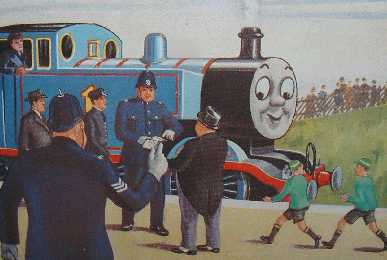
I think that the modernised version of the stories and the careful animations are still quite delightful and a pleasure to watch, even at my age. There has been an attempt to preserve the original feel of the stories but perhaps it is simply the materials that the models are made from which to me jar a little and are in conflict with the cherished memories I have of the book versions.In those days all school boys wore a cap and short trousers. Try and get them to do that today !
Those books have a nostalgic magic for me, part of which are the miniature masterpiece colour plates from the brush and pen of C. Reginald Dalby, Awdry's illustrator. Each time I go back and look at them, that magic is there. Whilst television animation has brought these charming steam train characters to life for the ease of modern audiences of children who love them, some of that original magic can't be translated to television . Back then your imagination brought the little trains to life. Even as a young child in the fifties, the illustrations conjured up a time that preceded my own generation by a few years and so we have glimpses of buildings and vehicles from earlier years which add to the charm of the images.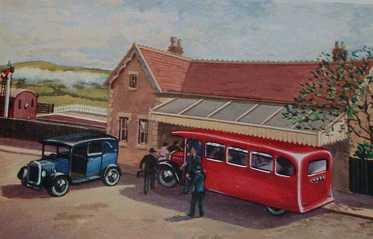
Like Awdry I spent my early years within earshot of huge steam trains and I was a regular visitor to the local railway sheds where the engines were maintained, and marshalling yards near Weymouth station. I loved to stand on the cast iron railway bridge as one of these huge, powerful black monsters huffed and puffed their way under me, wrapping me briefly in huge puff breaths of steam with that characteristic smell and those tiny fragments of coal ash.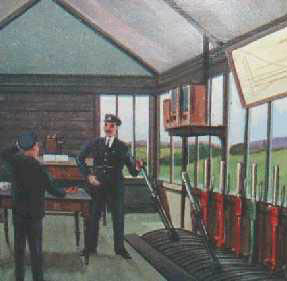
There were the mechanical railway signals and water spouts by the dirty brown and black ballasted tracks and the signal boxes. Within these elevated small buildings a man would physically throw long levers to change the points to enable a train to cross from one set of tracks to the other. We even had a unique railway curiosity in the town that gave us our own real Thomas the Tank engine. Weymouth was a cross-channel link by steam ship in my childhood days and you could take the 'Boat Train' from London.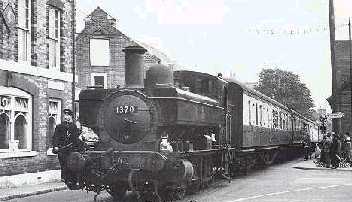
When it arrived at Weymouth station a tank engine would pull the carriages through the town, holding up the traffic, and up to the dockside where passengers then transferred to the old ships on their way to Jersey and Guernsey two of the Channel Islands. That railway track in the road surface is still there and a hazard, as it always was, to cyclists but alas the steam trains have long since been broken up for scrap and the railway yards have been built over with super-stores and housing.
Fatherhood provided an opportunity to relive these childhood days when I built a miniature railway set for my boys. I still have one of the engines from that time in my new home, made by the famous HORNBY company who produced working scale models of steam trains in fine detail for enthusiasts and which themselves have become collector's items.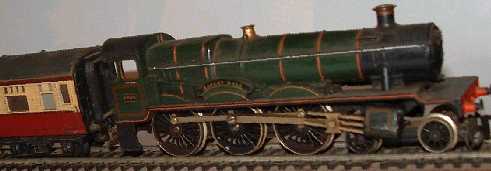
Even though the steam train has long since been replaced with what to me are a range of charmless, functional modern diesel or electic powered engines, I don't have to travel too far if I want to relive the golden age of steam. A group of dedicated local enthusiasts have restored a derelict part of the old East Lancashire Railway line between Bury and Rawtenstall and restore and run the old engines.

A visit there recently brought back all those associated memories and one in particular. As a child of twelve I just about contained my excitement when I went from Weymouth to the northern town of Leeds by train on my own. In those days they were compartment-carriages with high backed richly upholstered seating (that wasn't vandalised) and above each were framed pictures of British scenes and above that netted luggage racks. You could smell the smoke or have it blow over you if you dropped the window. The trains( in those days when 'chuff-chuff' was a very young child's baby word for a train)clickerty-clacked over the joins between the rail sections singing in harmony with the rythmic chuffing of the steam engine. That journey adventure sticks in my mind, even now, holding as I do an exquisite image-catalogue of a less crowded more green and pleasant Britain. Clean rivers and patchworks of green, green fields enclosed in hedgerows, unfolded in front of me from the carriage window. It was if that window was a film screen.
johncoxon 7:43 PM - [Link] - Comments ()
...
THE PLAYINGFIELDS OF ENGLAND
Thursday, May 15, 2003
This lovely pub sign I photographed for a previous entry (Click)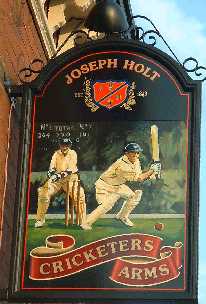
hangs from the wall of a local Holts' traditional British hostelry near us. It brings back fond memories. At the age of eleven I was sent to a local, old fashioned, fee paying, private school. It had 'boarders' (kids that lived at the school in monk-like, utilitarian dormitories and they had, it seemed to me, just bread and jam for tea!) This old fashioned establishment, in a huge Victorian house, had cast iron-framed oak pupil desks with lifting lids and inkpots in them. The teachers wore black flowing academic gowns and some used a bamboo cane to whip you on the hands to help instil 'discipline.'
I dimly recall upsetting aging, balding but normally gentle chemistry teacher, Mr Blatchford, whose ancient cane broke when he struck me across the palm ! I also remember, unfondly, a sadistic (devout Christian) lay priest, called Mr Green, ('Froggy Green') who taught what we called 'Divinity' (Religious Studies/ Christianity only) He was a fat, obscene looking man with clouded spectacles as dim as his vision and thick as the bottom of a beer glass. He'd cane kids merely for moving their feet. I remember that pal Ronny got caned once for squirming in his seat. He had been playing hide and seek in the school grounds. There was a huge thicket of bamboo near the main building, whose shiny green canes we used to cut to make peashooters. Ronnie squatted on a short, dangerously sharp bamboo stub and impaled his anus. M. Green didn't take excuses. Whack, whack.
Then there was 'Commander' O'Brien, a freckled, earnest, ex-Royal Navy man who was the Maths teacher. In those days you could use military service, if you had been an officer, as a 'qualification' to teach, and officers maintained the vanity of keeping their rank as a title. (We dubbed him the 'Admiral') He taught in a huge octagonal classroom with a vast Victorian mahogany desk raised on a plinth that we used to call the 'Admiral's bridge.' He preached and did not teach. He looked out at us over his half-framed spectacles, clutching his solid leather brief case, and occasionally lectured us about earthly, manly things that stunned us into embarrassed silence. I speak, of course, about those things that boys occasionally do, in the 'struggling with their sexuality' department, but which we should pass over in silence!
In that environment you didn't have the luxury of a Christian name. Teachers called you by your surname. My best memory is of the 'Admiral' uttering the famous words, in that way he had of stretching out his phrases for emphasis. "Coxon!", he bellowed. "Mathematics is eeeeesy. It's people like you that make it difficult!"
The school embodied traditional values, one of which was the view that compulsory sport on the playing fields of England developed character. No one had calculated that, for people like me, incompetence in ball team games was demoralising and very damaging to my sensitive ego. It is probably the reflective, objective mindset I adopted to steel myself, on the windswept expanses of the vast Redlands playing fields, where the seeds of my writing urges were sown. I was hopeless at sport, all sciences and maths, but I was the star pupil when it came to English and Literature. Even then I had the gift of standing back and laughing at the futility of it all.
To my mind , there was nothing sensible or useful to be gained by freezing to death in shorts and a flimsy tee shirt, occasionally thrusting my misguided , raw leather-studded boot at a slippery muddy leather orb , in the grassy slime , when, on very rare occasions the football rolled near to me. I often ended up standing , lonely as a cloud, contemplating the waste of time of it all as the token goalkeeper in football games. And then, to add to the indignity, there was the awful compulsory lukewarm shower at the end of proceedings. Remote playing field changing rooms are desolate, cold, concrete-floored horrors that stank of sweaty bodies and embrocation; medical smelling creams , the stuff the tougher guys rubbed on their legs that eased aching muscles, kept them warm, and burned you if they smeared it on you where you wouldn't want it !
And then, in the summer, there was our national game that I was expected to take part in. Essentially there was a huge field. And at the centre of it was a narrow mown corridor of grass, the cricket 'pitch.' At each end were three sticks crowned with wooden 'bails'. These sticks are called 'stumps.'
Now traditionally, the game of cricket perplexes foreigners and also people like me. It is incredibly dull to watch. This site will tell you everything you need to know about the subtleties and rules of the game should you want to know.Cricket Academy
In cricket, there are two teams. The people that aren't batting 'field'. That is they stand, usually way off and try to catch the ball and thus render the batsman 'out' as long as the ball doesn't hit the ground before they catch it. You have bowlers. Some deliver the ball agonisingly slowly or at an alarming rate.
Fast bowlers can throw this chunk of hard cork stitched and seamed in leather at 80mph plus. Twenty two yards away, this ball is thrown at the person holding the willow cricket bat.
To get him dismissed you either deliver a ball that he hits and someone catches, or you hit the wicket ( the three wooden sticks he tries to defend.) 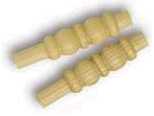
These lathe turned bits of wood across these three sticks or stumps are called the bails. If the ball you launch or 'bowl' dislodges the bails, then the guy walks. Now that image on that lovely pub sign evokes memories of tranquil games of cricket on the village green. The men in the picture are protected from that hard ball, should it glance them the occasional uncomfortable blow, with leg pads (and cricket gloves to protect their knuckles.( Their heads bear soft felt caps and the skill with the bat was their real defence against those red cannon balls
They didn't have, in those early days, that essential private insurance ; something tucked in their trousers to protect those delicate bits between their legs from the crack of that missile. In modern cricket, the batsmen are padded all over and wear hard-hat helmets, often with face guards. I once was on the field at Redlands when one unfortunate lad got hit right between the legs with a rocket of a ball. As he dropped to his knees , gasping for breath, one unkind person murmured, "Don't; rub them , count them". The unfortunate rubbed the tears from his eyes and limped of the field of play, 'retired hurt' as we used to say.
Now in cricket, when you feel you have got the batsman out, you have to appeal to the umpire ( referee) to agree to your perception of a dismissal by shouting out very loud and enthusiasticaly,arms rised in expectant triumph, Howzat! (How's that? or Is he out?) As that kid got hit directly by a scorcher right in the gravy box, someone shouted,"Howzat?" "Damn sore", one of the team retorted. Nowadays there are hard plastic or fibre glass 'boxes that you tuck down your jockeys to protect your genitals
from the cricket ball should you take a direct hit down there.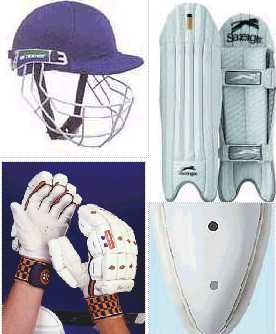
Sensible Modern Cricket Protection
I know just how hard a cricket ball is. I had the misfortune, once, to have been struck by one, skied by some hefty older kid and it came down, eventually, with a sickening thud, on my head. Mercifully I have a very thick skull and thick hair and from then on I had a bit of kudos amongst those sporty types, at last, because I was the guy that wasn't even affected by what, for anyone else, would have been a fatal blow ! (Years later that skull saved me again, when I was rear shunted by a light-headed German landscape gardener who rammed into the back of my car and my head shattered my windscreen. I was completely unhurt even though the car was a write-off!)
Now the mysterious sport of cricket is as perplexing to many just as the American game of baseball is for me, but the two have something in common. Essentially, the game hinges of the ability of the bowler (pitcher) to deliver a ball that defies the rules of physics. And the person on the receiving end is only as good as his ability to make split-second decisions where he either swipes embarrassingly at thin air when deceived, or gives the ball a satisfying full-hit into outer space. Each game has its own peculiar language to describe parts of the game, things you can do with the ball and so on.
I read that, our national game had its roots way back in the thirteenth century when shepherds played a ball game in front of a farm fence, striking it with their curved staffs or crics. Hence cricket. If you would like the experience of facing and trying to predict a cricket ball being thrown at you, click on this image from the game and try your luck at it.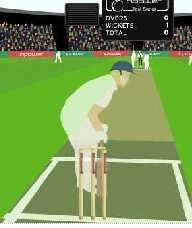
johncoxon 2:22 AM - [Link] - Comments ()
...
LAUGHING COW
Wednesday, May 14, 2003

I am very fond of this image on the ciruclar packaging of the French 'Laughing Cow' foil wrapped triangular processed cheese, 'La Vache Qui Rit.'(Literally the 'cow who laughs' but marketed in Britain as the Laughing Cow cheese)
In my job, as teacher of French language and culture to kids who struggle to learn, I try to provide them, where possible, with things in the learning environment which are authentic and add to that sense of foreigness in my room which aids their understanding and learning.
The above example is actually now on the wall of our kitchen now but once formed part of a display I made for my classroom. I simply took the original container to the local library and got a very large, high quality colour photocopy of the original image. Next I cut out two circles of insulating board to which I glued the cut out image. I did a computer drawing of the logo and text that normally is seen on the edge of the cheese boxes and multi -copied them to make a band graphic that I could paste onto my model to add to the authentifity. I also colour photocopied the little label that appears on each of the triangular segments that actually contain the cheese portions, mounted them on silver foil and produced a second item that showed the interior of the box for the pupils. I was trying to give them an idea of the foods that are typically French and yet which we can buy in our supermarkets and I went to a lot of trouble with this diplay.
In my teaching area, I have made a wooden replica French post box from this photograph I once took in Paris,
as well as a Tabac sign ( the red and white symbol for a shop licensed to sell tobacco products) I also reproduced a range of authentic shop front signage which I have over my display boards, that I made using a hand-held 'fret saw ' to cut out the lettering and to give the feel of a French town. My greatest classroom extravagance, was to pay £10 for an authentic full sized plan of the Paris underground. I wall-paper pasted it to a board, drilled and inserted little linked green and red LCD's to a battery, framed it , and produced a fully working model of those interactive Metro maps that you find on every Paris subway station. The kids love playing with it and i so enjoyed making it for them.
johncoxon 1:30 PM - [Link] - Comments ()
...
RELIGIOUS ICONS
Tuesday, May 13, 2003
Being an atheist is not a disdavantage in teaching about religions, although, spiritually speaking I bend towards many of the ideas of Buddhism. What Buddha looked like doesn't pose me any problems. There are no immediately contemporary paintings of him or statues, so the images that we see in 'rupas' reflect what someone thinks he ought to look like. Essentially he is going to be in one of a range of postures, seated or reclining, or standing, have his hand in one of a range of symbolic gestures called mudras, and have one of those lovely peaceful looking smiles and perhaps a hint of enlightened radience in his look. Here is a small sample from my P.C. library of some two hundred photographs of different images of the Buddha from around the world.
Buddhist rupas (statues) come in a range of racial features that reflect the culture of the sculptor and the 'essence' of the Buddha, rather than what he actually looked like ( which we can never know.) This Chinese version once belonged to my Grandma and is one of those smiley faced portly Buddhas connected with bringing good fortune to the owner's life.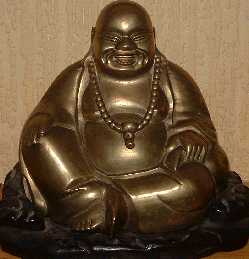
What did Jesus Look Like ?
I went to a seminar recently as one of quite a large group of educators looking at developing the use if information technology in teaching Religious Education. One of the delegates mentioned the difficulty she had dealing with kids' questions about what Christ looked like and whether it was possible, for example, that Jesus was black. In a lot of images, Christ is shown with long hair, a beard and very often a 'white' face. I suggested the line I take with the children who have learning difficulties that I teach.
We have an idea what Caesar looked like from the time of Christ, I tell them ( though in simpler language ), since their pan-theology allowed portraiture and statues but the Jews, in first century Palestine, were forbidden, by religious laws, to have 'craven' images or idols. Thus there is no record of what He may have actually looked like and there is no biblical reference describing His physical appearance. So, different artists portray Him in different ways, often reflecting the culture of the artist and created in their imagination. Again I have a library of digital images of Christ from around the world. I took this example, though, from our nearby Catholic church, St. Luke's. which has this statue in its garden.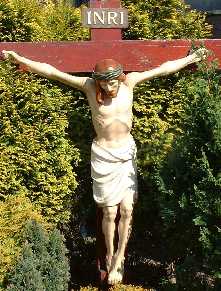
In this unremarkable, rather crude and sentimental, close up interpretation, Christ's face is white Caucasian. Yet you would imagine that a person native to Palestine would have a darker skin. In all the iconography I have seen thus far, paler hues dominate. I wonder whether Christ would have been bearded or long-haired in such a warm country and whether the beard and the long hair are simply a sort of iconic coding to make him look wise and attractive. These images don't of course have to be accurate because they have a religious, purely symbolic, purpose. Many of them have been produced by pious people like monks and thus have a partisan representative purpose, with a tendency to be romanticised, idealised images just like so many other statues and paintings. The majority of images do not focus on Christ in an everyday posture but elect to focus on the crucifixion since, as I understand it, it is the pivotal point in the belief system as are events around what happened next and they define what is unique in that faith.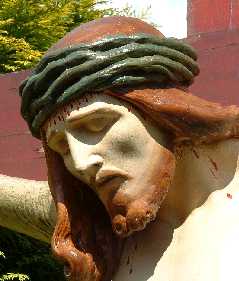
I needed my Catholic friend, Celia, to tell me why there are these icons of Christ and why they were necessary. She told me that, for many people, an image helped some to meditate and focus on their beliefs in moments of quiet reflection. I could identify with that since I don't 'worship' Buddha, but do notice his images around my house; that wry, kindly smile that seems to tease me benignly; it reminds me to focus on the truths I think he represents and thus keep on track. So, I concluded, from what Celia told me, that it doesn't really matter what cosmetic hue images of Christ have , whether he is bearded or long haired. After all, these images are simply symbolic, there to remind people what they believe in and how they ought to act as they proceed.
Finally, here is another close up of that Catholic statue near my school which bothers me a tad.
Some images of Christ, in the agony of Roman crucifixion, have his hands bound, as well as nailed, and in this local Catholic church example, standing on a block although pierced through crossed legs (and as you notice, pulling no punches when it comes to graphically including blood from various wounds.) I have a problem with this version, and I have an x-ray of a human hand in my classroom to stimulate discussion amongst my pupils. I want to illustrate, and ask them to question, the likelihood of the nails being driven into the palm of His hands, where, scientifically, anatomically speaking, Christ's body-weight could not have been supported if the nails went in there. Above the wrist would be more logical in a scientific sense.
So why, I ask myself, are there so many images where, traditionally, the nails are in the palm? I remember the 'stigmata', are they called ? (The marks that Chnst showed to His colleagues to prove it was Him after he returned to them from the dead.) Scars in the area above the wrist would have been equally credible. Yet there is something horrifically more poignant in having been nailed through the hands and I guess that was the point various artists have been trying to make. Some of my close friends are Christians and I know that I perplex them with my cynicism. I am no scientist, but Iam O.K. with the Christ thing up to the point where He returns from the dead.
Because I have to teach my pupils this religion, I can at least accept that this person existed now from my research. (I was spooked, incidentally, by a scientific/astrological verification of the 'Star of Bethlehem 'phenomenum recently. That research puts the actual year of Christ's birth into question because of the mathematical mistake made by a monk called,was it, Derick? who miscaluclated the reigns of various rulers when creating his version of chronology from which we now mark time. At the point of all that happened, allegedly, after the crucifixion, Christians and I part company, ideologically and dogmatically speaking. I can't, too,
buy into the version of reality that goes 'how can someone who lived two thousand years ago still be so significant for so many millions wordwide if it isn't all true!' The miracle thing also has me unimpressed, thinking you can believe what you want to believe and thus he could have done those things though I don't believe it. All these people can't be wrong.' I don't say they are; I do say it doesn't make any sense to me , but I accept their right to believe whatever they wish to believe, especially if that makes them happy and a positive influence in our crazy, dangerous world. After all said and done, we all have our own picture of the thing or person we believe in, but the picture isn't the thing ; it is what it represents for us, or should be. I respect people's pictures, even if they are not mine.
(I have followed the convention, here throughout, of using a capital letter when refering to Christ with a pronoun,( even though I am profoundly not a Christian) to acknowledge his importance to so many people, just as I would, if I said the name of Mohamed, (PBUH), in my lessons about Islam, suffix it immediately with 'Peace be upon him', because I want my kids to respect the beliefs of others, whether or not they find those beliefs credible and relevant to their own experience. I feel awkward and unsure in doing this in both cases but go with my gut feeling and do it anyway because it seems right.)
johncoxon 11:14 PM - [Link] - Comments ()
...
PHOTO QUIZ ( ANY OLD IRON )
Monday, May 12, 2003
I hate to see things discarded that I can find a use for, and these two Edwardian cast iron objects are no exception. I found them rusting, half buried, in builder's rubble that had been 'fly tipped' ( illegally dumped to save disposal fees) on two different spots of local waste ground.
I was delighted with my find and knew exactly how I could use them. I simply gave them a good thrashing with a wire brush and then painted them with 'Hammerite' enamel paint then screwed them to the garden walls as plant holders.
Can you guess what they were for originally? These are fairly plain examples; some are highly decorative, especially the Victorian and early Edwardian ones. Cast iron then was the universally used, mouldable material of choice but of course required regular maintenance. Nowadays these objects are made in plastic and require, therefore, no maintenance. The old cast iron variety are, sadly, being smashed down and replaced with modern, cheap to manufacture, lightweight pvc versions. These are universally bland and utilitarian in design. The new version is prone to deteriorate and becomes brittle because of UVA.
So what were they once used for ? Click on the image to find out more. 
johncoxon 7:15 PM - [Link] - Comments ()
...
THE BRITISH SNAIL-MAIL OUTBOX

We have London's black cab and red double-decker bus. We have the British 'Bobby' ( named after the diminutive form of the name Robert, 'Bob, because Sir Robert Peel formed the first police force here known also as 'Peelers.') We have 'Bobbies' with the famously pointed but actually impractical (from a protective and comfort point of view) navy-blue helmet. We have the bright red, multi-paned telephone box, now sadly sort of extinct. Then there is the post-office red pillar box, one of the five most recognisable British street icons.
In 1980, the trusty, tending to rusty , gorgeously-glaring red, cast iron pillar-shaped letter box was, incomprehensibly, abandoned. We have lost that magic sense it gave of cast-iron solidness and continuity forever. Didn't we invent postage stamps? 
With the introduction of this all new (for the sake of it?) horribly standardised modern design, in high impact fibre glass or cast iron ,something precious, to me at least, was lost.
Reassuringly these hideous replacements are not universal and there are still so many originals to comfort us. The traditional Royal Mail colour of what we call 'Post Office' red has been retained. So too the tradition of embossing the royal cipher of the reigning monarch on the front of the box. (There is a great British post box connoisseur website that gives you these ciphers and so much more. Click in the image to visit them.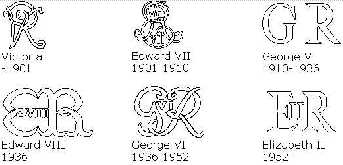
We have used the monogram letters VR, GR, and are on ER the second time around. The R is either Latin for King or Queen,(regina or rex) and we have had our Victoria (the first queen to her monograph posted all over), our Edward and, since the early 1950's , the current Queen, Elizabeth, who has been on mail boxes since I celebrated her coronation fireworks aged three in 1953. Liz and me go way back.
As I have posted previously, I have very mixed feelings about the Monarchy and hope that it gets a major make-over when the current monarch ceases to be and the crown passes on to one of her family. {Aside, stage left:- One of the perks of the British monarch job is that you get your own cipher on every street public letter box. And when you do actually sign something yourself (instead of getting some factotum to write on your behalf, even though you never actually got to read the letter that pleb sent) you can sign yourself, first name only, Elizabeth, even with Roman numerals after it if you are feeling particularly smug, and no one else can officially. This is in direct contrast to lower royals who simply sign with their title name ,'Westminster', 'Kent' etc, etc. What total arrogance and nonsense is that! Madonna, Sting, Prince, Sade et al, are you the royals of music?}
Did you know, by the way, historically there is a reason (but I forget why at this moment) that on our coins of the realm, ascending monarchs face the opposite way to the previous incumbent? If Charles takes over, he'll have a sinister orientation. [facing left] Word is that coins will have appendages to accommodate his remarkable pinna.
Now, in terms of my late life nostalgic delusion, there is something comforting in British icons like the pillar box. Throughout my life I have been comforted by the horizontal slot in my red cylinder of preference mail box but, when I look into things, I see that this icon of British-ness was not the faithful constant I once though it was.
It has, like all things, evolved in terms of physical shape, size ,materials and orientation of the place you post things even. There is this world wide thing, the stereotypical comforting idea that provides a Brit with that separateness of identity within the family of man. Yet these convenient icons have to be challenged in a tell it how it is sort of way.
Buses have been 'de-regulated' so the London bus competes in the capital now with single-deckers and all sorts of company names. Taxis come in all shapes and colours and even traditional 'Hackney' cabs, don't have to be black, are covered in adverts, have a new shape, and can accommodate wheel chairs. They still are predominantly diesel engined, retain their remarkable turning circle, but of course also, the total taxi driver indifference to the rules that normal road-users adhere to are now, as traditionally, ignored. Bobbies wear body armour waist coats, and have belts with night sticks, radios, hoodlum-repellent sprays, cuffs etc and want a different style helmet, if they have to have one, that actually protects their head and is comfortable.
Trouble with icons is that we seem to want them as permanent symbols, say of nationality. Research reveals otherwise and a range of variants. We have had, I learned , hexagonal letter boxes, even ones with a letter slot that was vertical in the letter boxes' formative years.
The royal city of Bath, with its Roman hot springs and preserved Georgian crescent buildings is home to a remarkable Postal Museum
Curiously our local remaining Victorian post box is somewhat stouter, broader than the norm.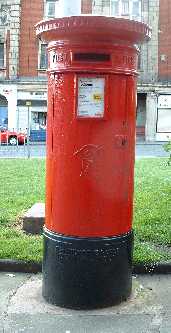
Early boxes had slim slots because letters were smaller. Later, envelopes got bigger and so the slot increased in size. ( I always puzzled that receptacles for rectangular posted things were indeed cylindrical.) Actually, post-people, these days, are often weighed down with junk-mail fliers as well as regular post, and the normal post boxes have developed cuboid warts either to increase box space or for the 'posties' to leave part of their letter bulk safe while they post and then can come back for more. 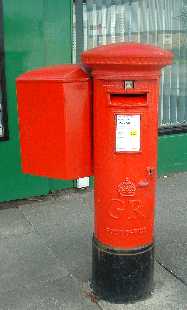
Once again, a simple web search reveals a range of specialist sites. Some people collect post boxes, others maintain informative and authoritative sites about them like the Letter Box Study Group
There are also a large number of beautiful stamps which celebrate the British post box with an array of lovely images. Click on this example to visit one such stamp enthusiast site and see other great images.
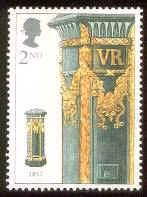
johncoxon 3:03 AM - [Link] - Comments ()
...